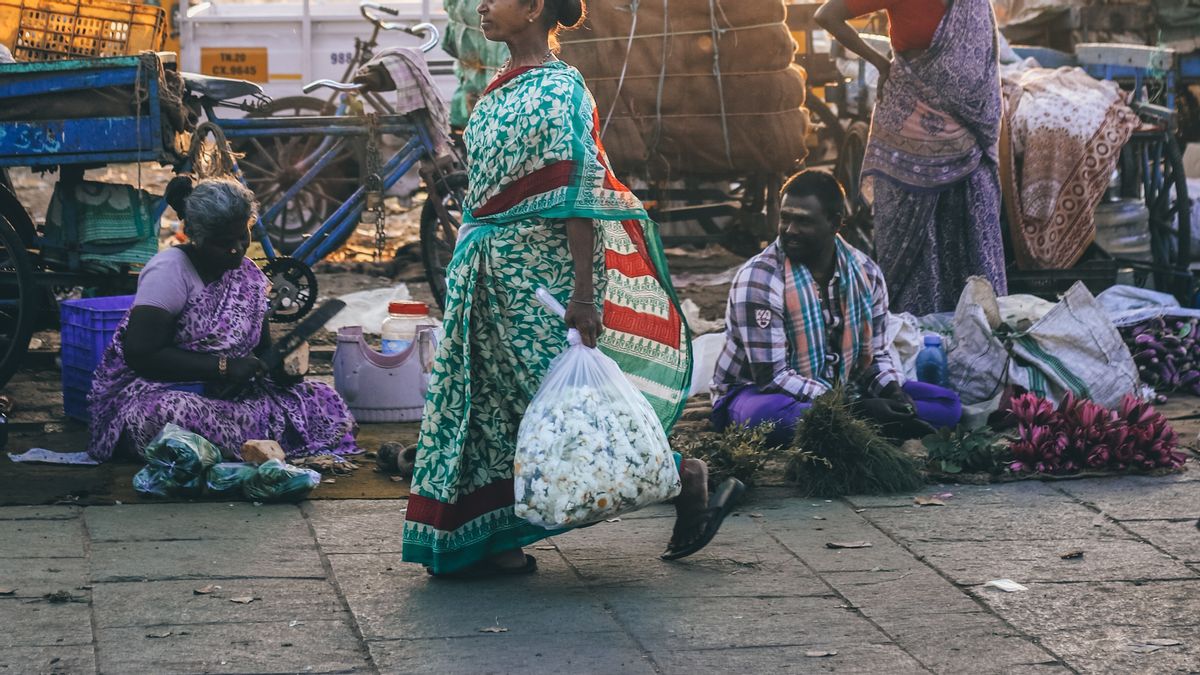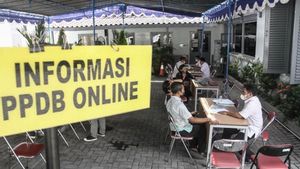JAKARTA - The lockdown policy in India creates problems for the lower classes. The lockdown policy even seems to be only able to be carried out by those who have privileges or privileges.
For residents who are well off, they can practice self-isolation at home, work at home, and order food via delivery services comfortably. However, outside their window, the story went in a different way.
Workers and poor people spilled on the streets. They were starving and homeless. One proof of this can be seen from a video recording uploaded on Twitter belonging to the @AnjaliB_ account.
In the recording, a woman can be seen admonishing a group of people who were hanging around right under her window. They then replied to the woman with a desperate expression. "There are 400 of us who have no food. We need help. There are lots of children too," said one of the crowd.
No food supply for last 3 days at night shelter in Motia Khan which has 400 people, including women & children. @AamAadmiParty government must closely monitor the food distribution. Put information on demand & actual supply in public domain. #COVID pic.twitter.com/OTC729SQAC
- Anjali Bhardwaj (@AnjaliB_) March 26, 2020
Meanwhile, as reported by the NPR, Indian roads in some places do look deserted from vehicles, but are instead enlivened by ragged-looking pedestrians. Some of them were seen carrying bundles of items that were placed on their heads.
"I just want to go home," said one young man who was interrupted by sobs when being interviewed by an Indian TV reporter. The young man said he just wanted to walk home from the capital New Delhi where he worked to his home in the eastern state of Bhiar. At least he had to travel about 600 miles or about 965 kilometers. Almost like the distance from Jakarta to Banyuwangi.
आनंद विहार बस अड्डे से बड़ी संख्या में मजदूर तपके के लोग पैदल जा रहे हैं, दिल्ली से वापस अपने घर जाना चाहते हैं, लेकिन जाने का कोई साधन नहीं, न जेब में पैसा है, एक लड़का काफी रो रहा है कह रहा है पुलिस मारने के लिए दौड़ती है, हम कहाँ जाएं # lockdownindia #Corinnavirus pic.twitter.com/Cw5buZIzVP
- Mukesh singh sengar मुकेश सिंह सेंगर (@mukeshmukeshs) March 24, 2020
Many Indian migrant workers, believed to number around 120 million, try to walk to their hometowns. The distance is unmitigated, from hundreds to thousands of miles. Meanwhile, dozens of people have died in accidents on their way home.
There are actually no more COVID-19 cases in India than Indonesia. Until this news was made, there were 1,397 people who tested positive for COVID-19, with 35 deaths and 123 people recovered.
However, Prime Minister (PM) Narendra Modi has imposed one of the world's largest and most stringent lockdown policies. The Indian government ordered all residents to remain in their homes for 21 days from March 25. With the exception of essential workers, such as food stores and law enforcement officials.
A forced move
Still according to the NPR report, the lockdown has left tens of millions of migrant workers unemployed. They mostly come from rural areas, but live most of the year overseas in the big cities of India. Some work as day laborers, construction workers, or domestic assistants.
Since the lockdown was implemented, many migrant workers have lost their homes. The reason is, not a few of them who live in factory dormitories, are so unable to pay their rent. However, due to restrictions, their dormitory is now closed.
Those who then decided to return to their hometowns were stranded because the government had stopped public transportation services, such as buses and trains, last week. In addition, they are also vulnerable to hunger and infection.
Indian economist Jean Dreze said that the ability of the poor to stay indoors is very short. According to him, people such as casual workers, rickshaw pullers and migrant workers basically depend on their daily income.
Now, said Dreze, the government suddenly announced that they had to spend 21 days inside their home. "Of course many of them have run out of food," said Dreze.
Last week, Indian Finance Minister Nirmala Sitharaman poured out a budget of more than US $ 22 billion to tackle the new coronavirus. Its main priority is to reach food for the poor.
However, according to economists, the budget will not be sufficient. "We need a much bigger stimulus, at least two or three times that amount," said Jayati Ghosh, an economist at Jawaharlal Nehru University.
He is also worried about the supply chain that the government says is safe. This is because disruptions in food supply can be very deadly for underprivileged people.
However, it is reported that India already operates the largest food distribution system in the world. Its government officials say they have enough grain stocks to feed the poor, for at least a year and a half.
Currently, economists have urged the government to immediately distribute these food stocks. Meanwhile, to solve the problem of migrant workers who are forced to return home because they do not have a place to live, the state sends a thousand buses to take them. Within hours, hundreds of thousands of people thronged Delhi's Anand Vihar bus station.
Problems like coming in repeatedly. The gathering of thousands of people in one place certainly creates a new problem, namely the potential for the massive spread of the corona virus. The authorities seemed to order them to keep a distance of more than one meter, as the World Health Organization appealed.
In addition, another potential concern is the transmission of COVID-19 in the villages where migrant workers return. This is because the areas that are far from the city center have less access to hospitals as in the city center.
There are only a small number of hospital beds and those with ventilators to treat the COVID-19 disease. In fact, doctors in India and public health experts warn that the explosion of COVID-19 cases on a larger scale than what happened in Italy and the United States is not impossible in India.
Due to the chaos that occurred after the lockdown, Indian PM Narendra Modi in his speech two days ago (30/3) apologized, especially to the poor who were affected. "I made some decisions that make you suffer, my poor brothers," said Modi. "But for a country like India, this is necessary."
Many migrant workers have traveled across India this week, who say how severe the coronavirus crisis is. On the one hand, they claim to respect government policies. However, on the other hand, they have no other choice but to find food outside their homes.
The English, Chinese, Japanese, Arabic, and French versions are automatically generated by the AI. So there may still be inaccuracies in translating, please always see Indonesian as our main language. (system supported by DigitalSiber.id)








